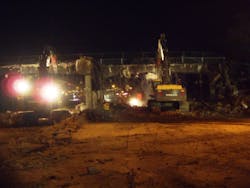BRIDGE RESCUE: Colorado DOT off to flying start to replace deficient bridges on U.S. 6
A power line helped create a power forward.
Plans for the reconstruction of U.S. 6 in Colorado originally called for a 20-night traffic shift, where lanes would gradually move over to their temporary resting place. Then Excel Energy stepped in with a challenge. A transmission line spanning over U.S. 6 to the Platte River Bridge needed to either be raised or the profile lowered, calling for a complete closure of U.S. 6. Already needing a weekend closure to demolish the Knox Court Bridge, lead designer Edward Kraemer & Sons was ready to steam ahead with a bolder approach—72 hours to take down the span, and the halves of five others, and execute the traffic shift.
“That Friday night when we closed they got the Knox Bridge demoed and then Saturday when you came during the daytime you could just see massive destruction,” Paul Sullivan, engineer with the Colorado Department of Transportation (CDOT), told ROADS & BRIDGES. “You saw people everywhere. There was equipment everywhere to bridge demos to power lines, crews trying to get the median barrier out and to do the patching.”
The last thing Colorado wants to see is structurally deficient bridges everywhere, which led to the creation of the state's Bridge Enterprise system a few years ago. The program funds spans in need, and on U.S. 6 alone there were three structurally deficient bridges—U.S. 6 over Bryant, U.S. 6 over the South Platte River and U.S. 6 over the BNSF railroad. All three are set to be completely demolished, along with three functionally obsolete ones—Knox Court, Federal Boulevard and U.S. 6 at I-25. According to Sullivan, the bridges were built back in the 1950s, and the structurally deficient ones were rated below 50 on a 0-100 scale. The Platte River and BNSF bridges were of the steel girder variety, while the U.S. 6 over Bryant was a parabolic concrete girder bridge. Sullivan said the deterioration was not that great, just enough on the bridge decks. New standards for shoulders and clearances dropped the Knox Court, Federal Boulevard and I-25 spans down to functionally obsolete.
“We were able to fund 48% of the project with Bridge Enterprise funding,” said Sullivan. “Otherwise we would not be able to do this.”
Phase 1 of the U.S. 6 reconstruction project began back in February. Traffic was moved to the south on U.S. 6, and all bridges except the Knox Court Bridge were partially demolished so traffic could still utilize them during construction. New sections, which will either be bulb T concrete girder or concrete box girders, will be constructed during Phase 1, as well as the first half of new concrete pavement on U.S. 6. The Knox Court Bridge is expected to be completely rebuilt by mid-summer.
Ramp structures throughout the corridor also are being modernized. Collector distributor ramps will be constructed to eliminate some dangerous weave movements, including the one with the highest accident rate at Bryant and U.S. 6. Currently, traffic coming off of Federal Boulevard that wants to take U.S. 6 into Denver has to merge over two lanes of traffic, and another major movement is trying to get to I-25.
“There is almost an accident a day at that location,” claimed Sullivan.
A bike/pedestrian bridge also will be constructed as part of the U.S. 6 renovation. The span will connect Barnum Park North with Barnum Park South. To complete a diamond interchange at Federal Boulevard, CDOT needed to acquire some of the park property, and to compensate for the loss CDOT offered to rebuild the green space and install the steel truss bike/pedestrian bridge.
Phase 1 is expected to be complete by the end of 2014, when the whole process of shifting traffic and demolishing portions of bridges will start over for Phase 2.
